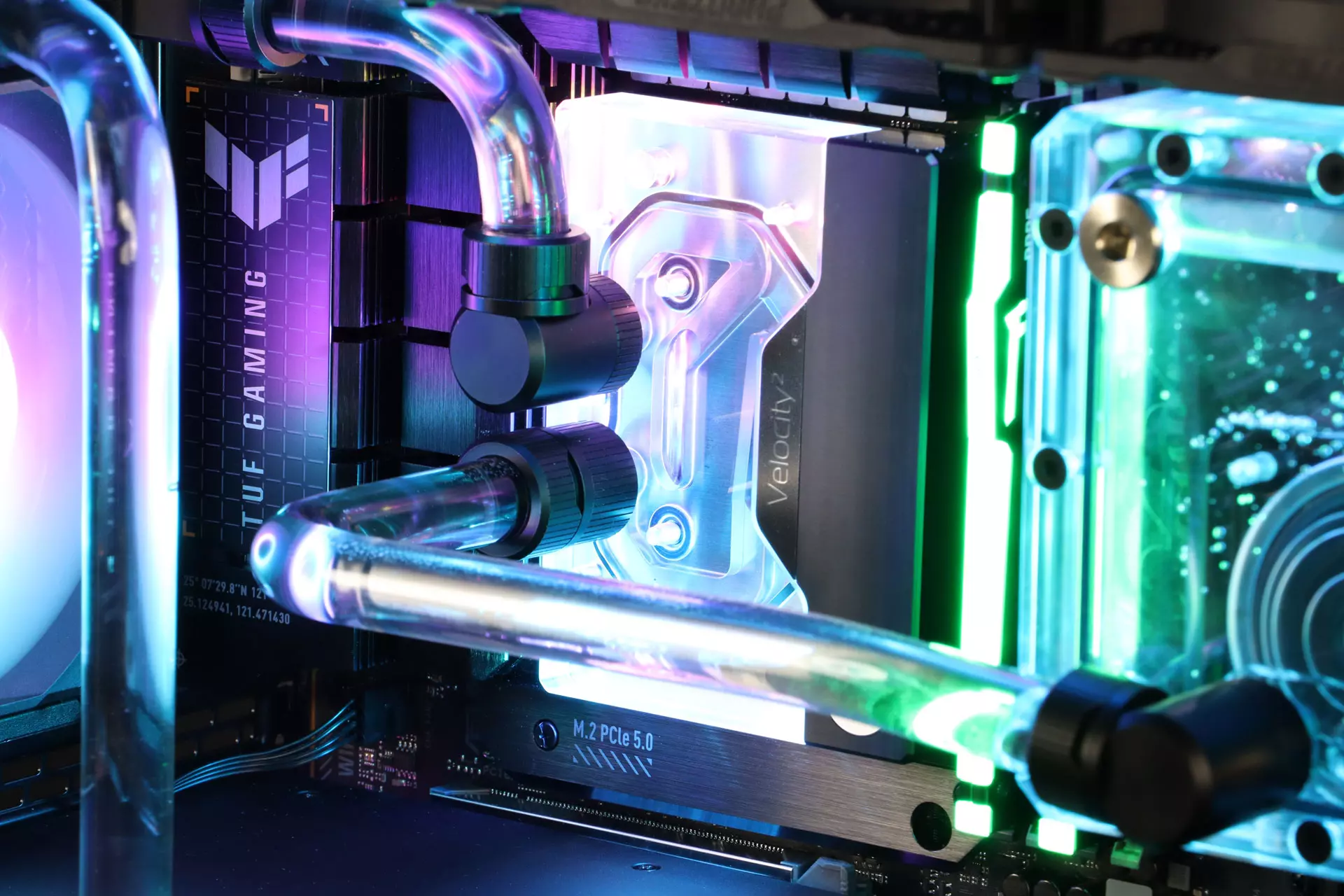By Jon M
Water and electronics don’t usually play well together, but one area where you can safely combine the two, is inside your desktop computer. Since water is an effective heat conductor, it can be used to effectively cool a computer’s hottest components. In some cases this can improve performance, but in most it helps to reduce noise levels and can make a computer look neater and tidier by pushing the big metal heatsinks into the case’s panels where they’re less obstructive.
Modern watercooling is easier and safer than ever, too, so you needn’t fear drips or leaks with a contemporary watercooled PC. Custom watercooling loops with gorgeous fittings and colorful pipework are one way to watercool your PC, but there are all-in-one (AIO) kits which are almost as good and far easier to install and maintain.
Whatever kind of watercooling you’re interested in for your computer, though, we’d love to tell you more about it. Here’s our guide to watercooling your computer.
How does watercooling work in a PC?
Watercooling works in a similar manner to air cooling, in that it’s used to move heat energy away from hot components. The way way it achieves that, though, is quite different, and it represents a different component in the chain of moving that heat away.
Where an air cooler uses a metal heatsink to pull the heat from the processor or graphics card; heatpipes to carry it to large metal fins, and then air to dissipate that heat outside the case, water plays a much more integral part in the heat transfer process than just the end.
Most watercooling loops involve a waterblock that sits on top of the hot component – that can be a CPU, GPU, or even a whole motherboard in some cases. That block is composed of a thick metal plate (copper or aluminum) that’s connected to a water loop by rubber, plastic, or glass tubing. As the processor heats up, it warms up the waterblock, which in turn transfers the heat to the water.
A pump pushes the water around the loop, away from the processor, and into a radiator. That radiator is made up of lots of metal fins which provide a large surface area for the heat to dissipate from. Large fans then push, or pull (or both) cool air across the radiator, cooling the water. The pump then sends it back on round the loop.

Benefits of water cooling in PCs
Watercooling is undeniably more complicated than air cooling. Even with an AIO there are multiple additional parts to a watercooler than there are with a traditional tower air cooler. But there are a number of reasons you might want to use a watercooler in your next PC upgrade.
For starters, if you want the absolute best cooling performance outside of sub-zero solutions, a custom watercooling loop will offer much greater thermal dissipating power than a standard air cooler. Even a really good one. That is more reserved for big loops with big radiators, but if you want extra cooling performance, there’s only so big air coolers can get. Water cooling loops are infinitely expandable. If you need to cool more, just add more radiators, more pumps, and more fans.
That added cooling power can lead to greater performance from graphics cards and processors, since they’ll be automatically able to run faster with a higher boost clock because they won’t get so hot when running at peak performance. If you’re interested in overclocking, custom watercooling loops give you all the extra headroom you need for higher clock speeds and higher voltages.
Both custom water cooling loops and AIOs can make a PC look a lot neater, too. By pushing the large metallic radiators into the top, front, or even floor of a case, that leaves a lot more room around the processor and other components. This can help with system airflow in general, although the lack of a CPU cooler pushing air down on to its immediate components, like the VRM and memory, needs to be accounted for in some more compact cases.
A PC that’s watercooled will typically operate quieter than a traditional air cooled PC, too. By having the radiators mounted in the side panels of a case, there’s usually room for larger fans, as well. That means they can move the same amount of air at lower speeds, which in turn means they produce less noise. This is especially apparent in PCs where both the processor and graphics card are watercooled, though that is usually only possible with large, custom watercooling loops.

Types of PC watercooling
The two main types of PC watercooling are custom, and all-in-one (AIO). An AIO watercooler is a self-contained, pre-filled watercooling loop made up of a waterblock and radiator, with an integrated pump somewhere within the loop. AIOs don’t require filling (or refilling, typically), are far cheaper than a custom loop, and require less time and effort to install. They also don’t require leak testing, since they are already tested for that at the factory.
A custom watercooling loop, on the other hand, tends to cost a lot more and be a lot more tricky to install, because you need to factor a lot more into the build. You’ll need to purchase individual components, like the waterblock, radiator(s), fans, and pump. You will likely want a reservoir too, and there are extras to consider like distribution plates and flow meters.
With a custom loop you also need tubing and fittings to connect the different components to the tubing. You have the option of hard or soft pipe work. Hard tubing is more costly and more complicated to install, but it does look very cool. Soft tubing, is comparably simply to install and far cheaper, but it doesn’t have that neat, professional look in quite the same way.
There are also different components that you can watercool. The most common one is the central processor, with most AIO kits designed to cool the CPU. There are graphics cards which are sold with pre-attached AIO watercoolers, though they tend to be rare, special editions of top cards which cost a lot more. There are also kits that let you mount CPU AIOs on graphics cards, but they are an even more niche application of PC watercooling.
Most watercooled graphics cards are fitted with a custom waterblock after purchase, and added to an existing custom watercooling loop. They’re not alone, though. Motherboards can be cooled with large monoblocks, which cool both the CPU and components on the motherboard, like the VRM. There are also some very niche memory kits which have watercooled heatspreaders, though additional memory cooling has dubious effectiveness when they already produce zero noise and don’t output much heat even when heavily overclocked.

How to build a watercooled PC
Building a watercooled PC is not much different to building an air cooled PC. All the components go in the same places, you just need to leave room to mount the radiators. If you’re building a custom loop, you’ll also need additional room for the pump and reservoir, and even more room if you’re using additional components like a distribution plate.
If you’re using an AIO, you’ll probably install that component last – assuming you can still fit the radiator into its mounting point in your case. A custom loop, however, may benefit from being installed alongside, or even before some of the other components. Particularly if you’re building it inside a compact case where room for your hands will be extremely limited once you’ve installed some of the components.
If you want a watercooled PC but don’t want to build it yourself, Chillblast can help. We have a range of watercooled PCs that are ready to ship right now, or we can custom build something perfectly suited to yours wants and needs. Just get in touch to see what kind of watercooled PC we can build for you.
Build a custom PC Build a custom Watercooled PC
Watercooled PC vs air cooled PC: Which is better?
There are advantages and disadvantages to both watercooled and air cooled PCs, so whether a water cooled PC is for you, is really down to you. There’s an argument to be made to do a little of both, though.
A PC that is cooled entirely by air, with a tower cooler on the CPU, a standard air cooler on the GPU, and RAM and VRMs cooled by system fans, will be cheaper than a water cooled PC. It will likely perform about the same – especially if you buy a good tower CPU cooler – and it will be as easy to build and maintain as any gaming PC. It might be a little noisier, depending on the components you’re cooling and the fan curves you set for your system cooling, but you can always adjust that after the fact.
A PC that has an AIO watercooler on the CPU, but air cooling everywhere else, will cost a little more (depending on the AIO you choose), but it will probably be a little quieter. It will look a bit neater too, with less metal work around the CPU making it easier to see your other components through the side window – if you have one. Performance should be about the same as a good tower air cooler, so you probably won’t see lower temperatures over long sessions of using the PC. Installing an AIO can be a little tricky, but it’s not much more complicated or as unwieldy as a big, heavy tower cooler.
A fully watercooled PC with waterblocks on the CPU and GPU, all hooked up to a custom loop, is the most expensive and complicated option to build. It has a greater number of moving parts, so has more potential for failure if a pump dies, or you spring a leak. However, it will almost certainly operate quieter and offer much better cooling performance. That can let you run a PC that is near silent even when at full load, and you may be able to push your components further for added performance too.
Pro tip: Chillblast can overclock your new PC for you, if you like. It doesn’t cost anything extra and it won’t even invalidate your warranty! Just ask one of our system building experts and they’ll talk you through what kind of extra performance you can expect.
Ongoing maintenance of a custom loop is more demanding than part-watercooled or air cooled PCs. You’ll need to replace the fluid in the loop at least once a year, and if you use colored water or other additives, you may need to flush the loop to clear any impurities from the blocks too.

Conclusion: Is a watercooled PC right for you?
Watercooling is easier today than it’s ever been, with AIOs offering simple watercooling solutions for those just interested in making their PC run quieter, and a huge selection of parts for those who want to take it further. You don’t need to be an expert PC builder to enjoy watercooling, though. Chillblast can build a watercooled PC for you. Our custom watercooled PCs are some of the best looking and best performing in the business, so get in touch if you want to talk through what kind of watercooled PC you could have, no installation or maintenance required.
But if watercooling isn’t for you, don’t fret. The latest generations of air coolers offer incredible performance at low noise levels, so you can have a cool and quiet PC without water just as easily.
Shop All PCs










